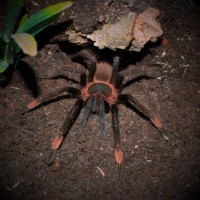joossa
Arachnobaron
- Joined
- Nov 21, 2020
- Messages
- 333
I am looking to get a B. boehmei in the future. I really like the ones with a completely orange carapace and would like to get a juvenile that exhibits that trait. However, I have noticed that there seems to be some variability in the carapace of this species. See photos attached (not mine) as examples.
It looks like some have a full orange carapace, some have some light black streaking, and some have a full blown B. emilia black triangle. So, some questions for discussion:
It looks like some have a full orange carapace, some have some light black streaking, and some have a full blown B. emilia black triangle. So, some questions for discussion:
- Do you all think this variability is just natural within the species?
- Do you think possible hybridization and subsequent back-breeding with other B. boehmei individuals has introduced and kept the variability?
- And the most important question for me as a prospective owner of a B. boehmei: Do any of you know if an indivual B. boehmei can potentially develop some black on the carapce as it grows from medium sized juvenile to adult? For example, If I buy a 3in juvinle that has a comepltely orange carapace, could it potentially develop some black as it molts and grows into adulthood? Has anyone experienced that with theirs?


